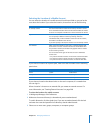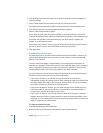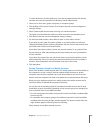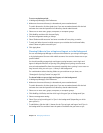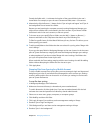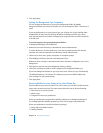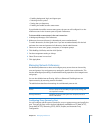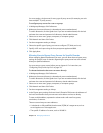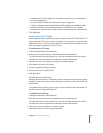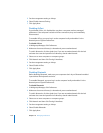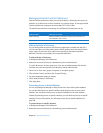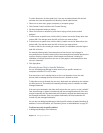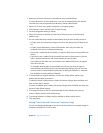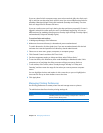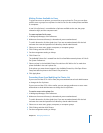
214 Chapter 10 Managing Preferences
You must assign a single server for every type of proxy server (for example, you can’t
have multiple FTP proxy servers).
To configure proxy servers for a user or a group:
1 In Workgroup Manager, click Preferences.
2 Make sure the correct directory is selected and you are authenticated.
To switch directories, click the globe icon. If you are not authenticated, click the lock
and enter the name and password of a directory domain administrator.
3 Select one or more users, groups, computers, or computer groups.
4 Click Network and then click Proxies.
5 Set the management setting to Always.
6 Select the specific type of proxy you want to configure (FTP, Web, and so on).
7 Specify a URL and a port using the form proxyserver.apple.com:8080.
8 Click Apply Now.
Allowing Users to Bypass Proxy Servers for Specific Domains
When managing Network preferences for users, you can allow them to bypass proxy
settings for specific hosts or domains. Bypassing the proxy server lets users connect
directly to specified addresses.
You must set up a proxy server before you can bypass it. For instructions, see
“Configuring Proxy Servers by Port” on page 213.
To choose the domains that users can access directly:
1 In Workgroup Manager, click Preferences.
2 Make sure the correct directory is selected and you are authenticated.
To switch directories, click the globe icon. If you are not authenticated, click the lock
and enter the name and password of a directory domain administrator.
3 Select one or more users, groups, computers, or computer groups.
4 Click Network and then click Proxies.
5 Set the management setting to Always.
6 In the “Bypass proxy settings for these Hosts & Domains” field, enter the addresses of
the hosts and domains that you want users to be able to connect to directly.
To enter multiple address, separate the subnet masks with new lines, spaces,
semicolons, or commas.
There are several ways to enter addresses:
 A subdomain or fully qualified domain name (FQDN) of a target server, such as
server1.apple.com or store.apple.com.
 The specific IP address of a server, such as 192.168.2.1.




